Enterprise Risk Management: A Comprehensive Analysis of H&M's Risks
VerifiedAdded on 2023/01/17
|16
|4256
|52
Report
AI Summary
This report provides a comprehensive analysis of Enterprise Risk Management (ERM) for the H&M group, a Swedish multinational clothing company. It begins by outlining H&M's aims, which include becoming a leader in sustainable fashion. The report then delves into risk thresholds, identifying key risks such as social changes (weather conditions), changes in customer taste and preference, financial risks, and operational risks. A detailed risk management process is presented, including risk identification, assessment, response development, and control. The report includes a risk register table and analyzes identified threats and opportunities, such as operational and financial risks, and changes in customer preference. It also examines existing controls and provides calculations of risk, along with mitigation actions to address the identified risks. The conclusion summarizes the key findings and recommendations for effective ERM within H&M.
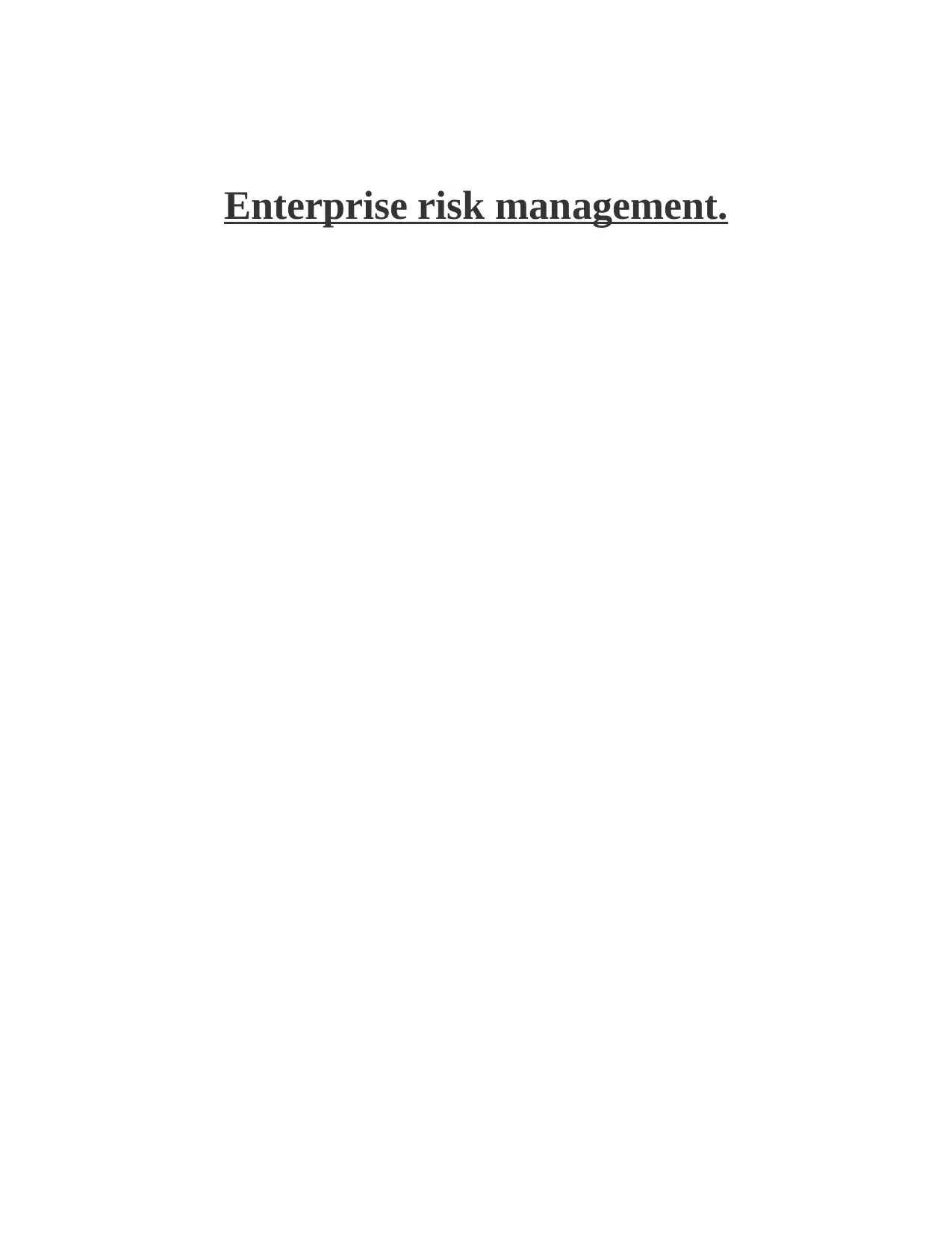
Enterprise risk management.
Paraphrase This Document
Need a fresh take? Get an instant paraphrase of this document with our AI Paraphraser

Table of Contents
INTRODUCTION...........................................................................................................................3
MAIN BODY...................................................................................................................................3
Aims of organization...................................................................................................................3
Risk thresholds............................................................................................................................3
Identified threats and opportunities.............................................................................................7
Existing controls..........................................................................................................................9
Calculations of risk...................................................................................................................10
Mitigation actions......................................................................................................................10
CONCLUSION..............................................................................................................................14
REFERENCES..............................................................................................................................15
INTRODUCTION...........................................................................................................................3
MAIN BODY...................................................................................................................................3
Aims of organization...................................................................................................................3
Risk thresholds............................................................................................................................3
Identified threats and opportunities.............................................................................................7
Existing controls..........................................................................................................................9
Calculations of risk...................................................................................................................10
Mitigation actions......................................................................................................................10
CONCLUSION..............................................................................................................................14
REFERENCES..............................................................................................................................15

INTRODUCTION
Risk management is the important and effective part of the enterprise because this creates
various problems for business and for its growth factors. It is regarded as the assessment and
identification of the risk. That is followed by the application of economic resources project and
the proper coordination in order to reduce the impact of unfortunate events. Risk management is
the process of identifying and assessing as well as controlling threats to an organization's capital
and earnings. The present report is based on the “H&M” group which is the Swedish
multinational clothing company known for its fast fashion clothing for men, women, teenagers
and children. The report will include the aim of organization with its possible risk which are
faced by company and make solutions for solve those risk in proper manner. This will also
identify and analyse the threats and opportunities with controlling techniques and calculations of
risk threshold. This will also apply by mitigations actions for enhance opportunity of business.
MAIN BODY
Aims of organization.
The H&M group aims to be a catalyst for sustainable change across the fashion industry
which is the Swedish fashion company has set itself some of the number has its highest
sustainability to the target customer. The more advanced sustainability of goals at the industry
today has proper uses of management. The main goal of company is to become 100% circular as
well as lead the changes to as sustainable fashion by being an equal and fair company in the
proper and effective manner. The main risk which is faced by company that are social changes
like “weather conditions” as the operating performance of the group particularly affecting sales.
This may give negative impact on company because that affect to sales of company.
Risk thresholds.
This is the amount of risk which an organization or individual is willing to accepts that
risk in proper manner by using various concepts. This shows a clear picture of risk which will
faced by H&M (Bromiley and et.al., 2015). The company is faced various risk which are
analysis by using risk management process. Risk management process is occurs proper uses of
work at the workplace by creating more and identifying proper risks which are faced by H&M
group. This includes four steps which are as follows:
Step: 1 Risk identification:
Risk management is the important and effective part of the enterprise because this creates
various problems for business and for its growth factors. It is regarded as the assessment and
identification of the risk. That is followed by the application of economic resources project and
the proper coordination in order to reduce the impact of unfortunate events. Risk management is
the process of identifying and assessing as well as controlling threats to an organization's capital
and earnings. The present report is based on the “H&M” group which is the Swedish
multinational clothing company known for its fast fashion clothing for men, women, teenagers
and children. The report will include the aim of organization with its possible risk which are
faced by company and make solutions for solve those risk in proper manner. This will also
identify and analyse the threats and opportunities with controlling techniques and calculations of
risk threshold. This will also apply by mitigations actions for enhance opportunity of business.
MAIN BODY
Aims of organization.
The H&M group aims to be a catalyst for sustainable change across the fashion industry
which is the Swedish fashion company has set itself some of the number has its highest
sustainability to the target customer. The more advanced sustainability of goals at the industry
today has proper uses of management. The main goal of company is to become 100% circular as
well as lead the changes to as sustainable fashion by being an equal and fair company in the
proper and effective manner. The main risk which is faced by company that are social changes
like “weather conditions” as the operating performance of the group particularly affecting sales.
This may give negative impact on company because that affect to sales of company.
Risk thresholds.
This is the amount of risk which an organization or individual is willing to accepts that
risk in proper manner by using various concepts. This shows a clear picture of risk which will
faced by H&M (Bromiley and et.al., 2015). The company is faced various risk which are
analysis by using risk management process. Risk management process is occurs proper uses of
work at the workplace by creating more and identifying proper risks which are faced by H&M
group. This includes four steps which are as follows:
Step: 1 Risk identification:
⊘ This is a preview!⊘
Do you want full access?
Subscribe today to unlock all pages.

Trusted by 1+ million students worldwide
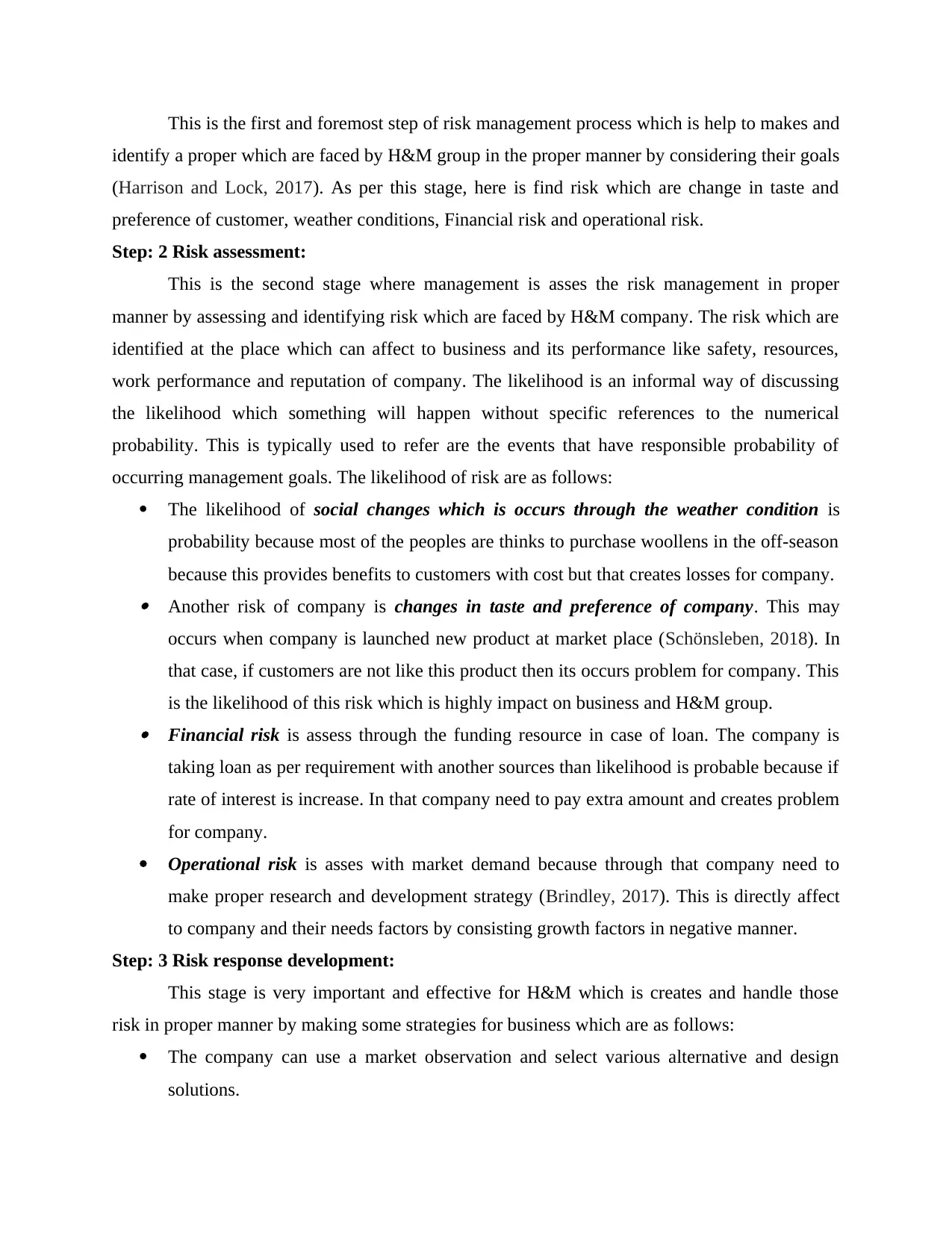
This is the first and foremost step of risk management process which is help to makes and
identify a proper which are faced by H&M group in the proper manner by considering their goals
(Harrison and Lock, 2017). As per this stage, here is find risk which are change in taste and
preference of customer, weather conditions, Financial risk and operational risk.
Step: 2 Risk assessment:
This is the second stage where management is asses the risk management in proper
manner by assessing and identifying risk which are faced by H&M company. The risk which are
identified at the place which can affect to business and its performance like safety, resources,
work performance and reputation of company. The likelihood is an informal way of discussing
the likelihood which something will happen without specific references to the numerical
probability. This is typically used to refer are the events that have responsible probability of
occurring management goals. The likelihood of risk are as follows:
The likelihood of social changes which is occurs through the weather condition is
probability because most of the peoples are thinks to purchase woollens in the off-season
because this provides benefits to customers with cost but that creates losses for company. Another risk of company is changes in taste and preference of company. This may
occurs when company is launched new product at market place (Schönsleben, 2018). In
that case, if customers are not like this product then its occurs problem for company. This
is the likelihood of this risk which is highly impact on business and H&M group. Financial risk is assess through the funding resource in case of loan. The company is
taking loan as per requirement with another sources than likelihood is probable because if
rate of interest is increase. In that company need to pay extra amount and creates problem
for company.
Operational risk is asses with market demand because through that company need to
make proper research and development strategy (Brindley, 2017). This is directly affect
to company and their needs factors by consisting growth factors in negative manner.
Step: 3 Risk response development:
This stage is very important and effective for H&M which is creates and handle those
risk in proper manner by making some strategies for business which are as follows:
The company can use a market observation and select various alternative and design
solutions.
identify a proper which are faced by H&M group in the proper manner by considering their goals
(Harrison and Lock, 2017). As per this stage, here is find risk which are change in taste and
preference of customer, weather conditions, Financial risk and operational risk.
Step: 2 Risk assessment:
This is the second stage where management is asses the risk management in proper
manner by assessing and identifying risk which are faced by H&M company. The risk which are
identified at the place which can affect to business and its performance like safety, resources,
work performance and reputation of company. The likelihood is an informal way of discussing
the likelihood which something will happen without specific references to the numerical
probability. This is typically used to refer are the events that have responsible probability of
occurring management goals. The likelihood of risk are as follows:
The likelihood of social changes which is occurs through the weather condition is
probability because most of the peoples are thinks to purchase woollens in the off-season
because this provides benefits to customers with cost but that creates losses for company. Another risk of company is changes in taste and preference of company. This may
occurs when company is launched new product at market place (Schönsleben, 2018). In
that case, if customers are not like this product then its occurs problem for company. This
is the likelihood of this risk which is highly impact on business and H&M group. Financial risk is assess through the funding resource in case of loan. The company is
taking loan as per requirement with another sources than likelihood is probable because if
rate of interest is increase. In that company need to pay extra amount and creates problem
for company.
Operational risk is asses with market demand because through that company need to
make proper research and development strategy (Brindley, 2017). This is directly affect
to company and their needs factors by consisting growth factors in negative manner.
Step: 3 Risk response development:
This stage is very important and effective for H&M which is creates and handle those
risk in proper manner by making some strategies for business which are as follows:
The company can use a market observation and select various alternative and design
solutions.
Paraphrase This Document
Need a fresh take? Get an instant paraphrase of this document with our AI Paraphraser
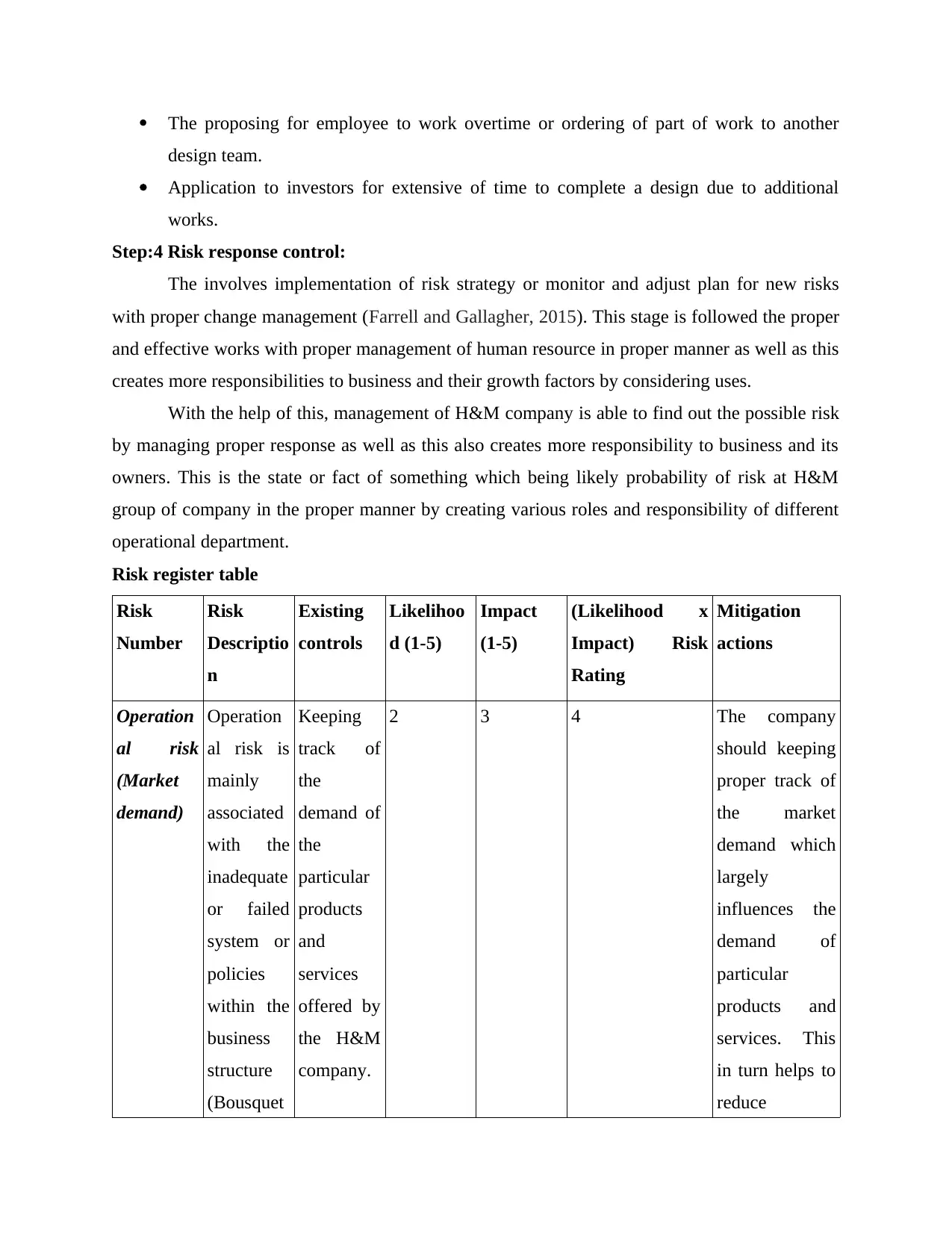
The proposing for employee to work overtime or ordering of part of work to another
design team.
Application to investors for extensive of time to complete a design due to additional
works.
Step:4 Risk response control:
The involves implementation of risk strategy or monitor and adjust plan for new risks
with proper change management (Farrell and Gallagher, 2015). This stage is followed the proper
and effective works with proper management of human resource in proper manner as well as this
creates more responsibilities to business and their growth factors by considering uses.
With the help of this, management of H&M company is able to find out the possible risk
by managing proper response as well as this also creates more responsibility to business and its
owners. This is the state or fact of something which being likely probability of risk at H&M
group of company in the proper manner by creating various roles and responsibility of different
operational department.
Risk register table
Risk
Number
Risk
Descriptio
n
Existing
controls
Likelihoo
d (1-5)
Impact
(1-5)
(Likelihood x
Impact) Risk
Rating
Mitigation
actions
Operation
al risk
(Market
demand)
Operation
al risk is
mainly
associated
with the
inadequate
or failed
system or
policies
within the
business
structure
(Bousquet
Keeping
track of
the
demand of
the
particular
products
and
services
offered by
the H&M
company.
2 3 4 The company
should keeping
proper track of
the market
demand which
largely
influences the
demand of
particular
products and
services. This
in turn helps to
reduce
design team.
Application to investors for extensive of time to complete a design due to additional
works.
Step:4 Risk response control:
The involves implementation of risk strategy or monitor and adjust plan for new risks
with proper change management (Farrell and Gallagher, 2015). This stage is followed the proper
and effective works with proper management of human resource in proper manner as well as this
creates more responsibilities to business and their growth factors by considering uses.
With the help of this, management of H&M company is able to find out the possible risk
by managing proper response as well as this also creates more responsibility to business and its
owners. This is the state or fact of something which being likely probability of risk at H&M
group of company in the proper manner by creating various roles and responsibility of different
operational department.
Risk register table
Risk
Number
Risk
Descriptio
n
Existing
controls
Likelihoo
d (1-5)
Impact
(1-5)
(Likelihood x
Impact) Risk
Rating
Mitigation
actions
Operation
al risk
(Market
demand)
Operation
al risk is
mainly
associated
with the
inadequate
or failed
system or
policies
within the
business
structure
(Bousquet
Keeping
track of
the
demand of
the
particular
products
and
services
offered by
the H&M
company.
2 3 4 The company
should keeping
proper track of
the market
demand which
largely
influences the
demand of
particular
products and
services. This
in turn helps to
reduce
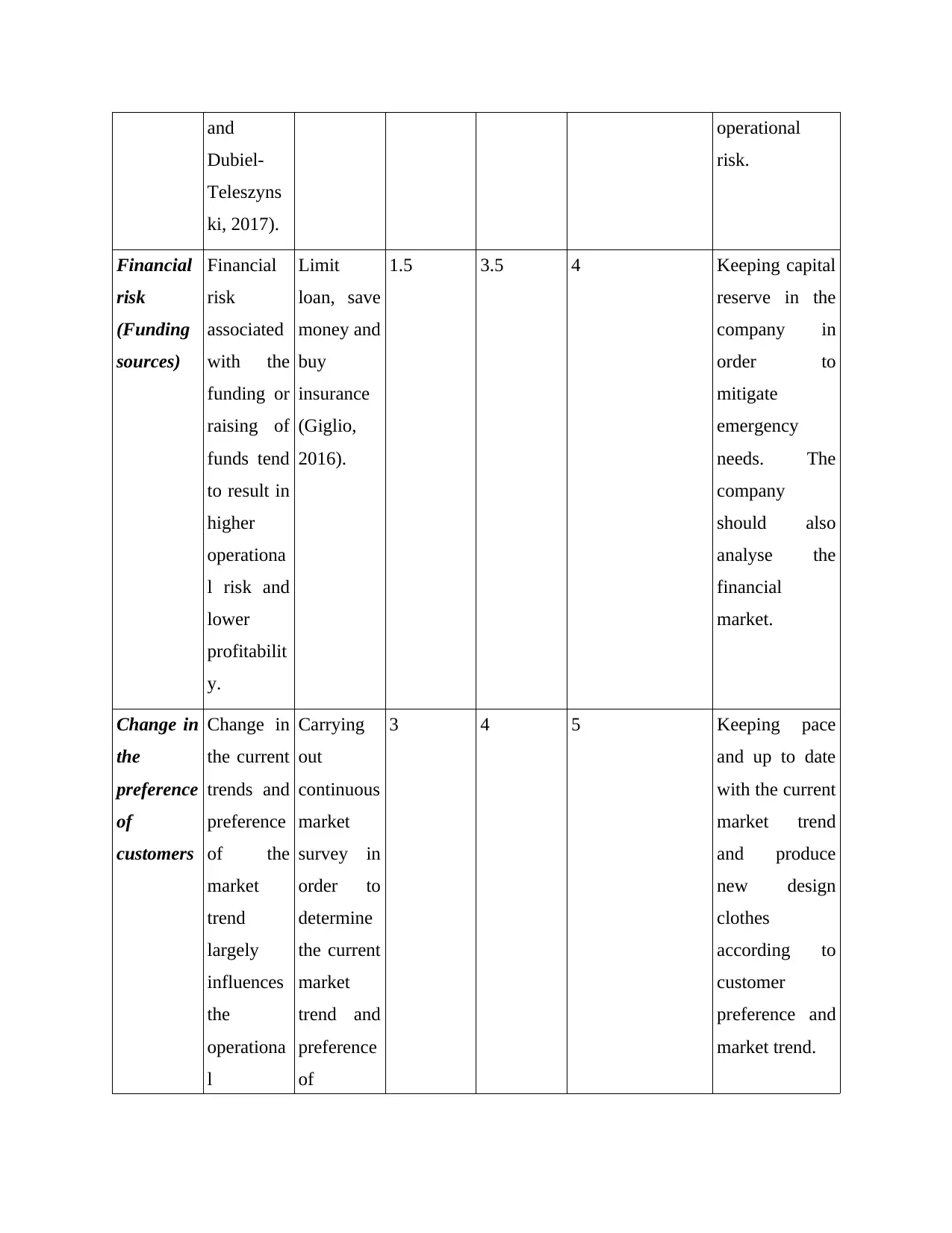
and
Dubiel-
Teleszyns
ki, 2017).
operational
risk.
Financial
risk
(Funding
sources)
Financial
risk
associated
with the
funding or
raising of
funds tend
to result in
higher
operationa
l risk and
lower
profitabilit
y.
Limit
loan, save
money and
buy
insurance
(Giglio,
2016).
1.5 3.5 4 Keeping capital
reserve in the
company in
order to
mitigate
emergency
needs. The
company
should also
analyse the
financial
market.
Change in
the
preference
of
customers
Change in
the current
trends and
preference
of the
market
trend
largely
influences
the
operationa
l
Carrying
out
continuous
market
survey in
order to
determine
the current
market
trend and
preference
of
3 4 5 Keeping pace
and up to date
with the current
market trend
and produce
new design
clothes
according to
customer
preference and
market trend.
Dubiel-
Teleszyns
ki, 2017).
operational
risk.
Financial
risk
(Funding
sources)
Financial
risk
associated
with the
funding or
raising of
funds tend
to result in
higher
operationa
l risk and
lower
profitabilit
y.
Limit
loan, save
money and
buy
insurance
(Giglio,
2016).
1.5 3.5 4 Keeping capital
reserve in the
company in
order to
mitigate
emergency
needs. The
company
should also
analyse the
financial
market.
Change in
the
preference
of
customers
Change in
the current
trends and
preference
of the
market
trend
largely
influences
the
operationa
l
Carrying
out
continuous
market
survey in
order to
determine
the current
market
trend and
preference
of
3 4 5 Keeping pace
and up to date
with the current
market trend
and produce
new design
clothes
according to
customer
preference and
market trend.
⊘ This is a preview!⊘
Do you want full access?
Subscribe today to unlock all pages.

Trusted by 1+ million students worldwide
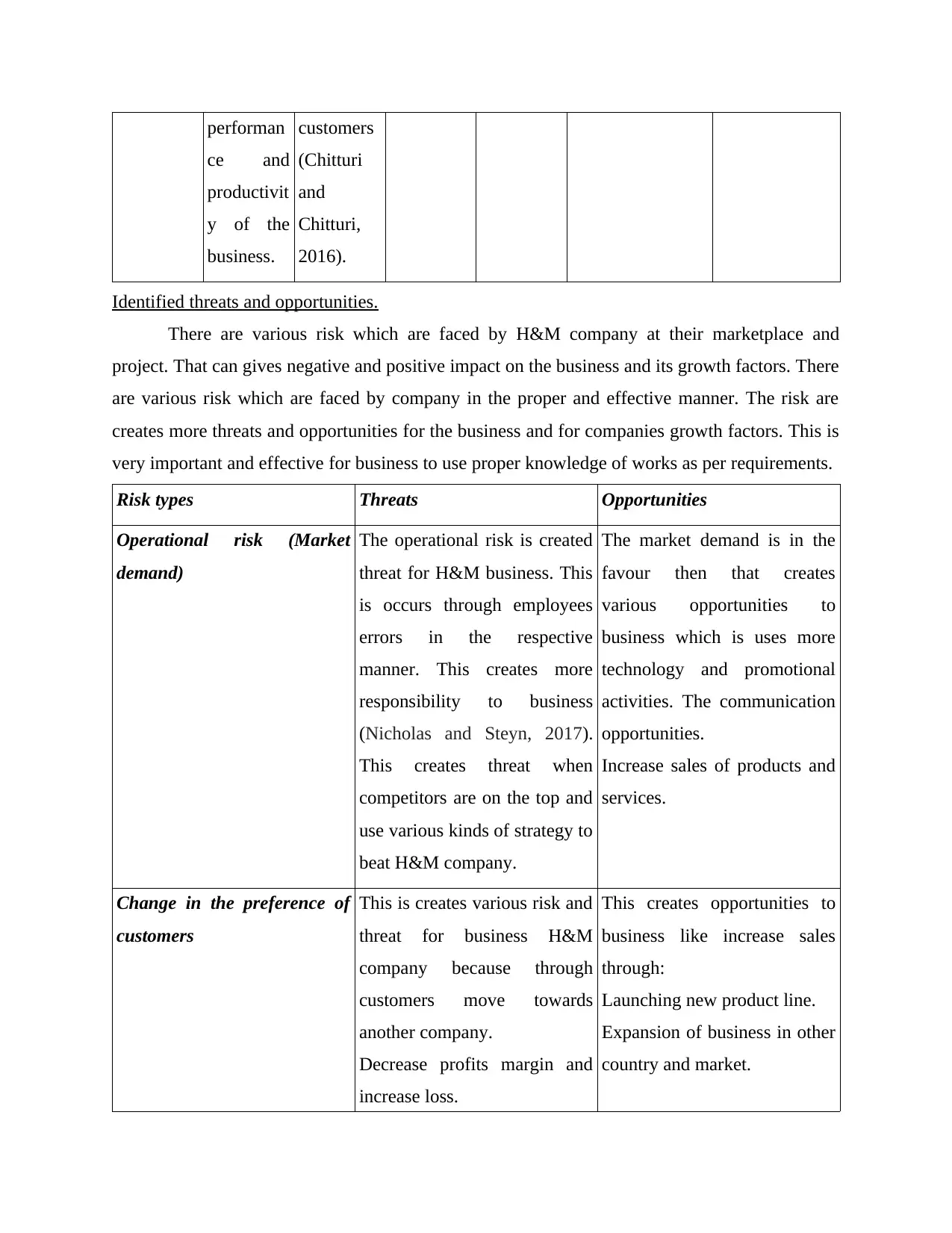
performan
ce and
productivit
y of the
business.
customers
(Chitturi
and
Chitturi,
2016).
Identified threats and opportunities.
There are various risk which are faced by H&M company at their marketplace and
project. That can gives negative and positive impact on the business and its growth factors. There
are various risk which are faced by company in the proper and effective manner. The risk are
creates more threats and opportunities for the business and for companies growth factors. This is
very important and effective for business to use proper knowledge of works as per requirements.
Risk types Threats Opportunities
Operational risk (Market
demand)
The operational risk is created
threat for H&M business. This
is occurs through employees
errors in the respective
manner. This creates more
responsibility to business
(Nicholas and Steyn, 2017).
This creates threat when
competitors are on the top and
use various kinds of strategy to
beat H&M company.
The market demand is in the
favour then that creates
various opportunities to
business which is uses more
technology and promotional
activities. The communication
opportunities.
Increase sales of products and
services.
Change in the preference of
customers
This is creates various risk and
threat for business H&M
company because through
customers move towards
another company.
Decrease profits margin and
increase loss.
This creates opportunities to
business like increase sales
through:
Launching new product line.
Expansion of business in other
country and market.
ce and
productivit
y of the
business.
customers
(Chitturi
and
Chitturi,
2016).
Identified threats and opportunities.
There are various risk which are faced by H&M company at their marketplace and
project. That can gives negative and positive impact on the business and its growth factors. There
are various risk which are faced by company in the proper and effective manner. The risk are
creates more threats and opportunities for the business and for companies growth factors. This is
very important and effective for business to use proper knowledge of works as per requirements.
Risk types Threats Opportunities
Operational risk (Market
demand)
The operational risk is created
threat for H&M business. This
is occurs through employees
errors in the respective
manner. This creates more
responsibility to business
(Nicholas and Steyn, 2017).
This creates threat when
competitors are on the top and
use various kinds of strategy to
beat H&M company.
The market demand is in the
favour then that creates
various opportunities to
business which is uses more
technology and promotional
activities. The communication
opportunities.
Increase sales of products and
services.
Change in the preference of
customers
This is creates various risk and
threat for business H&M
company because through
customers move towards
another company.
Decrease profits margin and
increase loss.
This creates opportunities to
business like increase sales
through:
Launching new product line.
Expansion of business in other
country and market.
Paraphrase This Document
Need a fresh take? Get an instant paraphrase of this document with our AI Paraphraser
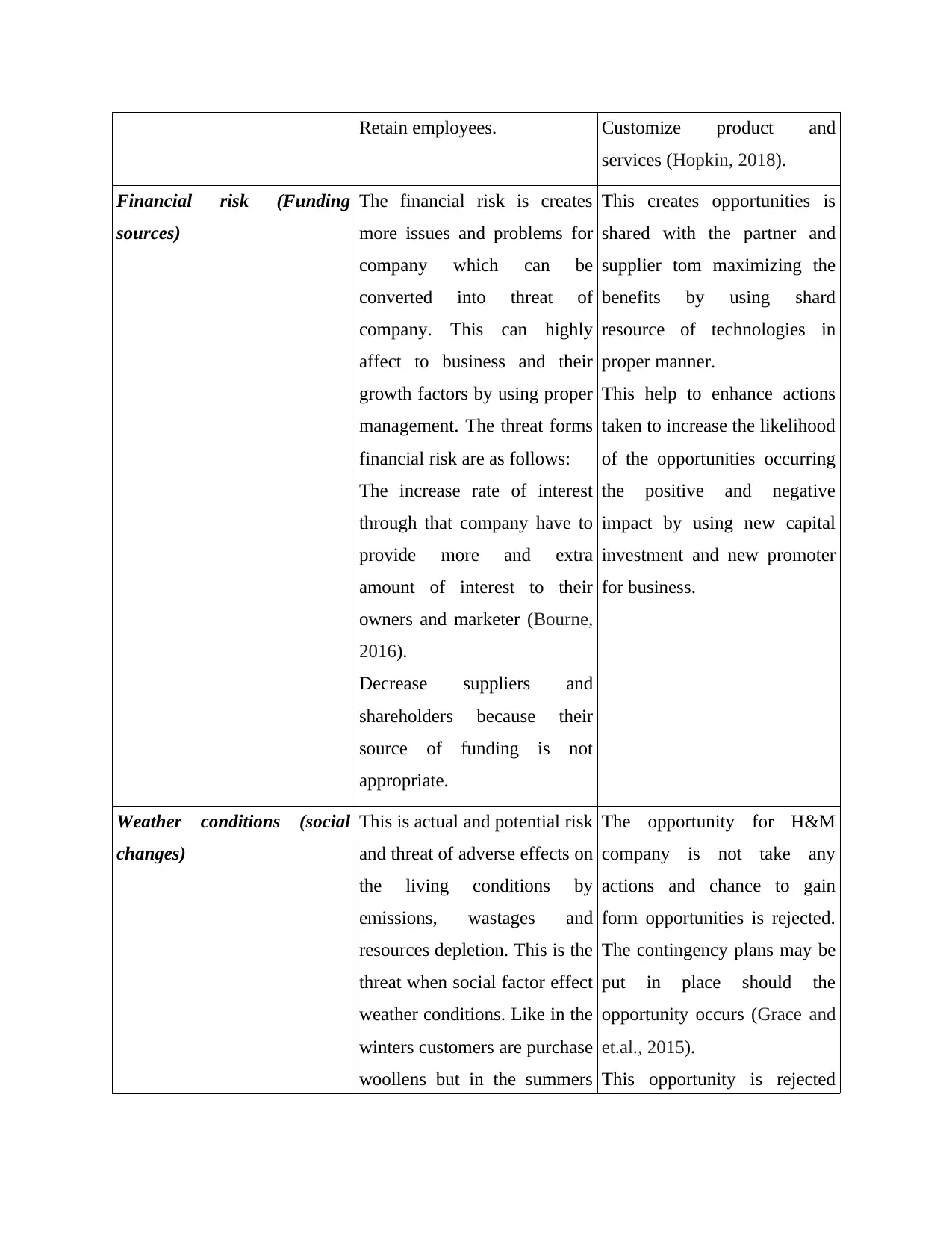
Retain employees. Customize product and
services (Hopkin, 2018).
Financial risk (Funding
sources)
The financial risk is creates
more issues and problems for
company which can be
converted into threat of
company. This can highly
affect to business and their
growth factors by using proper
management. The threat forms
financial risk are as follows:
The increase rate of interest
through that company have to
provide more and extra
amount of interest to their
owners and marketer (Bourne,
2016).
Decrease suppliers and
shareholders because their
source of funding is not
appropriate.
This creates opportunities is
shared with the partner and
supplier tom maximizing the
benefits by using shard
resource of technologies in
proper manner.
This help to enhance actions
taken to increase the likelihood
of the opportunities occurring
the positive and negative
impact by using new capital
investment and new promoter
for business.
Weather conditions (social
changes)
This is actual and potential risk
and threat of adverse effects on
the living conditions by
emissions, wastages and
resources depletion. This is the
threat when social factor effect
weather conditions. Like in the
winters customers are purchase
woollens but in the summers
The opportunity for H&M
company is not take any
actions and chance to gain
form opportunities is rejected.
The contingency plans may be
put in place should the
opportunity occurs (Grace and
et.al., 2015).
This opportunity is rejected
services (Hopkin, 2018).
Financial risk (Funding
sources)
The financial risk is creates
more issues and problems for
company which can be
converted into threat of
company. This can highly
affect to business and their
growth factors by using proper
management. The threat forms
financial risk are as follows:
The increase rate of interest
through that company have to
provide more and extra
amount of interest to their
owners and marketer (Bourne,
2016).
Decrease suppliers and
shareholders because their
source of funding is not
appropriate.
This creates opportunities is
shared with the partner and
supplier tom maximizing the
benefits by using shard
resource of technologies in
proper manner.
This help to enhance actions
taken to increase the likelihood
of the opportunities occurring
the positive and negative
impact by using new capital
investment and new promoter
for business.
Weather conditions (social
changes)
This is actual and potential risk
and threat of adverse effects on
the living conditions by
emissions, wastages and
resources depletion. This is the
threat when social factor effect
weather conditions. Like in the
winters customers are purchase
woollens but in the summers
The opportunity for H&M
company is not take any
actions and chance to gain
form opportunities is rejected.
The contingency plans may be
put in place should the
opportunity occurs (Grace and
et.al., 2015).
This opportunity is rejected
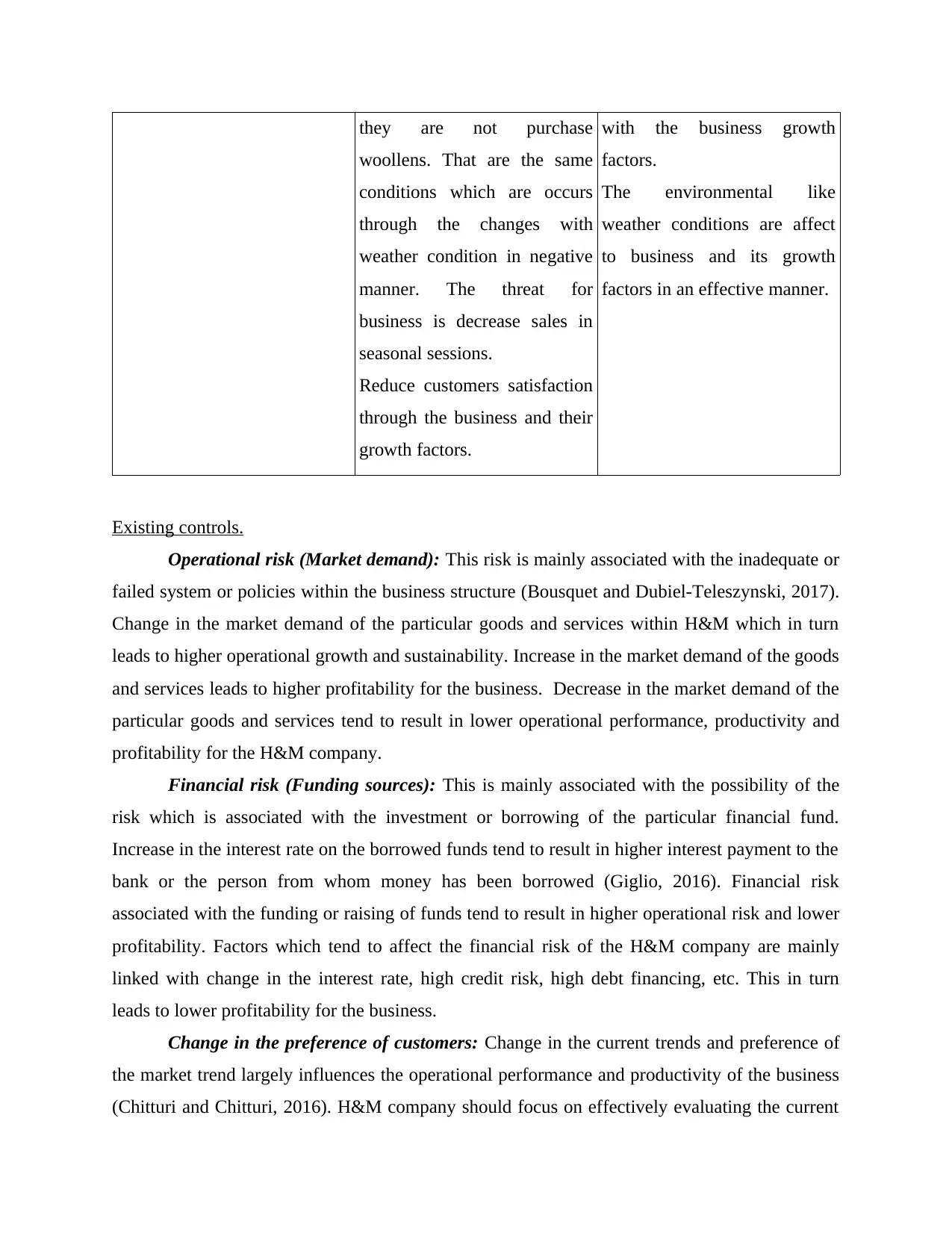
they are not purchase
woollens. That are the same
conditions which are occurs
through the changes with
weather condition in negative
manner. The threat for
business is decrease sales in
seasonal sessions.
Reduce customers satisfaction
through the business and their
growth factors.
with the business growth
factors.
The environmental like
weather conditions are affect
to business and its growth
factors in an effective manner.
Existing controls.
Operational risk (Market demand): This risk is mainly associated with the inadequate or
failed system or policies within the business structure (Bousquet and Dubiel-Teleszynski, 2017).
Change in the market demand of the particular goods and services within H&M which in turn
leads to higher operational growth and sustainability. Increase in the market demand of the goods
and services leads to higher profitability for the business. Decrease in the market demand of the
particular goods and services tend to result in lower operational performance, productivity and
profitability for the H&M company.
Financial risk (Funding sources): This is mainly associated with the possibility of the
risk which is associated with the investment or borrowing of the particular financial fund.
Increase in the interest rate on the borrowed funds tend to result in higher interest payment to the
bank or the person from whom money has been borrowed (Giglio, 2016). Financial risk
associated with the funding or raising of funds tend to result in higher operational risk and lower
profitability. Factors which tend to affect the financial risk of the H&M company are mainly
linked with change in the interest rate, high credit risk, high debt financing, etc. This in turn
leads to lower profitability for the business.
Change in the preference of customers: Change in the current trends and preference of
the market trend largely influences the operational performance and productivity of the business
(Chitturi and Chitturi, 2016). H&M company should focus on effectively evaluating the current
woollens. That are the same
conditions which are occurs
through the changes with
weather condition in negative
manner. The threat for
business is decrease sales in
seasonal sessions.
Reduce customers satisfaction
through the business and their
growth factors.
with the business growth
factors.
The environmental like
weather conditions are affect
to business and its growth
factors in an effective manner.
Existing controls.
Operational risk (Market demand): This risk is mainly associated with the inadequate or
failed system or policies within the business structure (Bousquet and Dubiel-Teleszynski, 2017).
Change in the market demand of the particular goods and services within H&M which in turn
leads to higher operational growth and sustainability. Increase in the market demand of the goods
and services leads to higher profitability for the business. Decrease in the market demand of the
particular goods and services tend to result in lower operational performance, productivity and
profitability for the H&M company.
Financial risk (Funding sources): This is mainly associated with the possibility of the
risk which is associated with the investment or borrowing of the particular financial fund.
Increase in the interest rate on the borrowed funds tend to result in higher interest payment to the
bank or the person from whom money has been borrowed (Giglio, 2016). Financial risk
associated with the funding or raising of funds tend to result in higher operational risk and lower
profitability. Factors which tend to affect the financial risk of the H&M company are mainly
linked with change in the interest rate, high credit risk, high debt financing, etc. This in turn
leads to lower profitability for the business.
Change in the preference of customers: Change in the current trends and preference of
the market trend largely influences the operational performance and productivity of the business
(Chitturi and Chitturi, 2016). H&M company should focus on effectively evaluating the current
⊘ This is a preview!⊘
Do you want full access?
Subscribe today to unlock all pages.

Trusted by 1+ million students worldwide
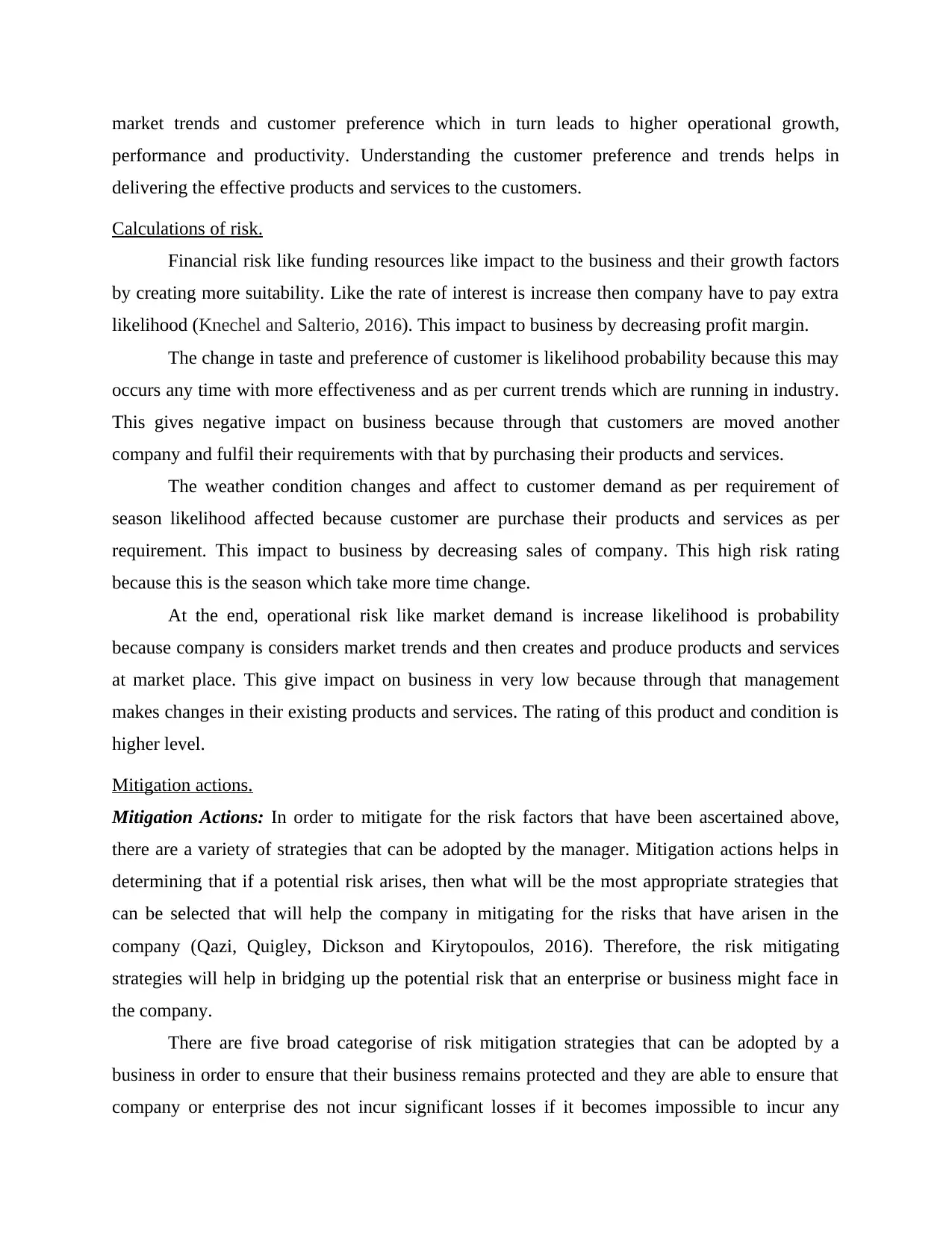
market trends and customer preference which in turn leads to higher operational growth,
performance and productivity. Understanding the customer preference and trends helps in
delivering the effective products and services to the customers.
Calculations of risk.
Financial risk like funding resources like impact to the business and their growth factors
by creating more suitability. Like the rate of interest is increase then company have to pay extra
likelihood (Knechel and Salterio, 2016). This impact to business by decreasing profit margin.
The change in taste and preference of customer is likelihood probability because this may
occurs any time with more effectiveness and as per current trends which are running in industry.
This gives negative impact on business because through that customers are moved another
company and fulfil their requirements with that by purchasing their products and services.
The weather condition changes and affect to customer demand as per requirement of
season likelihood affected because customer are purchase their products and services as per
requirement. This impact to business by decreasing sales of company. This high risk rating
because this is the season which take more time change.
At the end, operational risk like market demand is increase likelihood is probability
because company is considers market trends and then creates and produce products and services
at market place. This give impact on business in very low because through that management
makes changes in their existing products and services. The rating of this product and condition is
higher level.
Mitigation actions.
Mitigation Actions: In order to mitigate for the risk factors that have been ascertained above,
there are a variety of strategies that can be adopted by the manager. Mitigation actions helps in
determining that if a potential risk arises, then what will be the most appropriate strategies that
can be selected that will help the company in mitigating for the risks that have arisen in the
company (Qazi, Quigley, Dickson and Kirytopoulos, 2016). Therefore, the risk mitigating
strategies will help in bridging up the potential risk that an enterprise or business might face in
the company.
There are five broad categorise of risk mitigation strategies that can be adopted by a
business in order to ensure that their business remains protected and they are able to ensure that
company or enterprise des not incur significant losses if it becomes impossible to incur any
performance and productivity. Understanding the customer preference and trends helps in
delivering the effective products and services to the customers.
Calculations of risk.
Financial risk like funding resources like impact to the business and their growth factors
by creating more suitability. Like the rate of interest is increase then company have to pay extra
likelihood (Knechel and Salterio, 2016). This impact to business by decreasing profit margin.
The change in taste and preference of customer is likelihood probability because this may
occurs any time with more effectiveness and as per current trends which are running in industry.
This gives negative impact on business because through that customers are moved another
company and fulfil their requirements with that by purchasing their products and services.
The weather condition changes and affect to customer demand as per requirement of
season likelihood affected because customer are purchase their products and services as per
requirement. This impact to business by decreasing sales of company. This high risk rating
because this is the season which take more time change.
At the end, operational risk like market demand is increase likelihood is probability
because company is considers market trends and then creates and produce products and services
at market place. This give impact on business in very low because through that management
makes changes in their existing products and services. The rating of this product and condition is
higher level.
Mitigation actions.
Mitigation Actions: In order to mitigate for the risk factors that have been ascertained above,
there are a variety of strategies that can be adopted by the manager. Mitigation actions helps in
determining that if a potential risk arises, then what will be the most appropriate strategies that
can be selected that will help the company in mitigating for the risks that have arisen in the
company (Qazi, Quigley, Dickson and Kirytopoulos, 2016). Therefore, the risk mitigating
strategies will help in bridging up the potential risk that an enterprise or business might face in
the company.
There are five broad categorise of risk mitigation strategies that can be adopted by a
business in order to ensure that their business remains protected and they are able to ensure that
company or enterprise des not incur significant losses if it becomes impossible to incur any
Paraphrase This Document
Need a fresh take? Get an instant paraphrase of this document with our AI Paraphraser
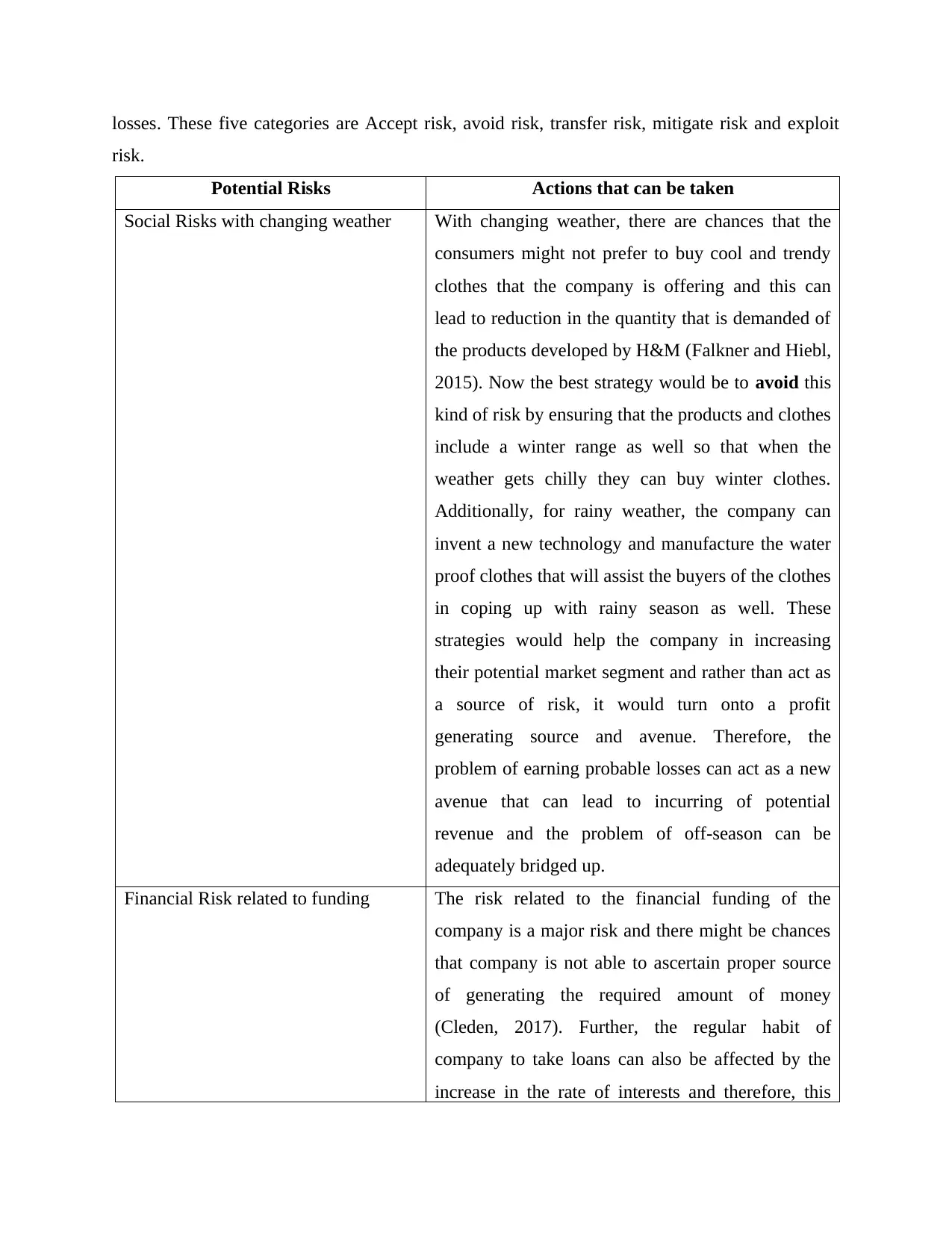
losses. These five categories are Accept risk, avoid risk, transfer risk, mitigate risk and exploit
risk.
Potential Risks Actions that can be taken
Social Risks with changing weather With changing weather, there are chances that the
consumers might not prefer to buy cool and trendy
clothes that the company is offering and this can
lead to reduction in the quantity that is demanded of
the products developed by H&M (Falkner and Hiebl,
2015). Now the best strategy would be to avoid this
kind of risk by ensuring that the products and clothes
include a winter range as well so that when the
weather gets chilly they can buy winter clothes.
Additionally, for rainy weather, the company can
invent a new technology and manufacture the water
proof clothes that will assist the buyers of the clothes
in coping up with rainy season as well. These
strategies would help the company in increasing
their potential market segment and rather than act as
a source of risk, it would turn onto a profit
generating source and avenue. Therefore, the
problem of earning probable losses can act as a new
avenue that can lead to incurring of potential
revenue and the problem of off-season can be
adequately bridged up.
Financial Risk related to funding The risk related to the financial funding of the
company is a major risk and there might be chances
that company is not able to ascertain proper source
of generating the required amount of money
(Cleden, 2017). Further, the regular habit of
company to take loans can also be affected by the
increase in the rate of interests and therefore, this
risk.
Potential Risks Actions that can be taken
Social Risks with changing weather With changing weather, there are chances that the
consumers might not prefer to buy cool and trendy
clothes that the company is offering and this can
lead to reduction in the quantity that is demanded of
the products developed by H&M (Falkner and Hiebl,
2015). Now the best strategy would be to avoid this
kind of risk by ensuring that the products and clothes
include a winter range as well so that when the
weather gets chilly they can buy winter clothes.
Additionally, for rainy weather, the company can
invent a new technology and manufacture the water
proof clothes that will assist the buyers of the clothes
in coping up with rainy season as well. These
strategies would help the company in increasing
their potential market segment and rather than act as
a source of risk, it would turn onto a profit
generating source and avenue. Therefore, the
problem of earning probable losses can act as a new
avenue that can lead to incurring of potential
revenue and the problem of off-season can be
adequately bridged up.
Financial Risk related to funding The risk related to the financial funding of the
company is a major risk and there might be chances
that company is not able to ascertain proper source
of generating the required amount of money
(Cleden, 2017). Further, the regular habit of
company to take loans can also be affected by the
increase in the rate of interests and therefore, this
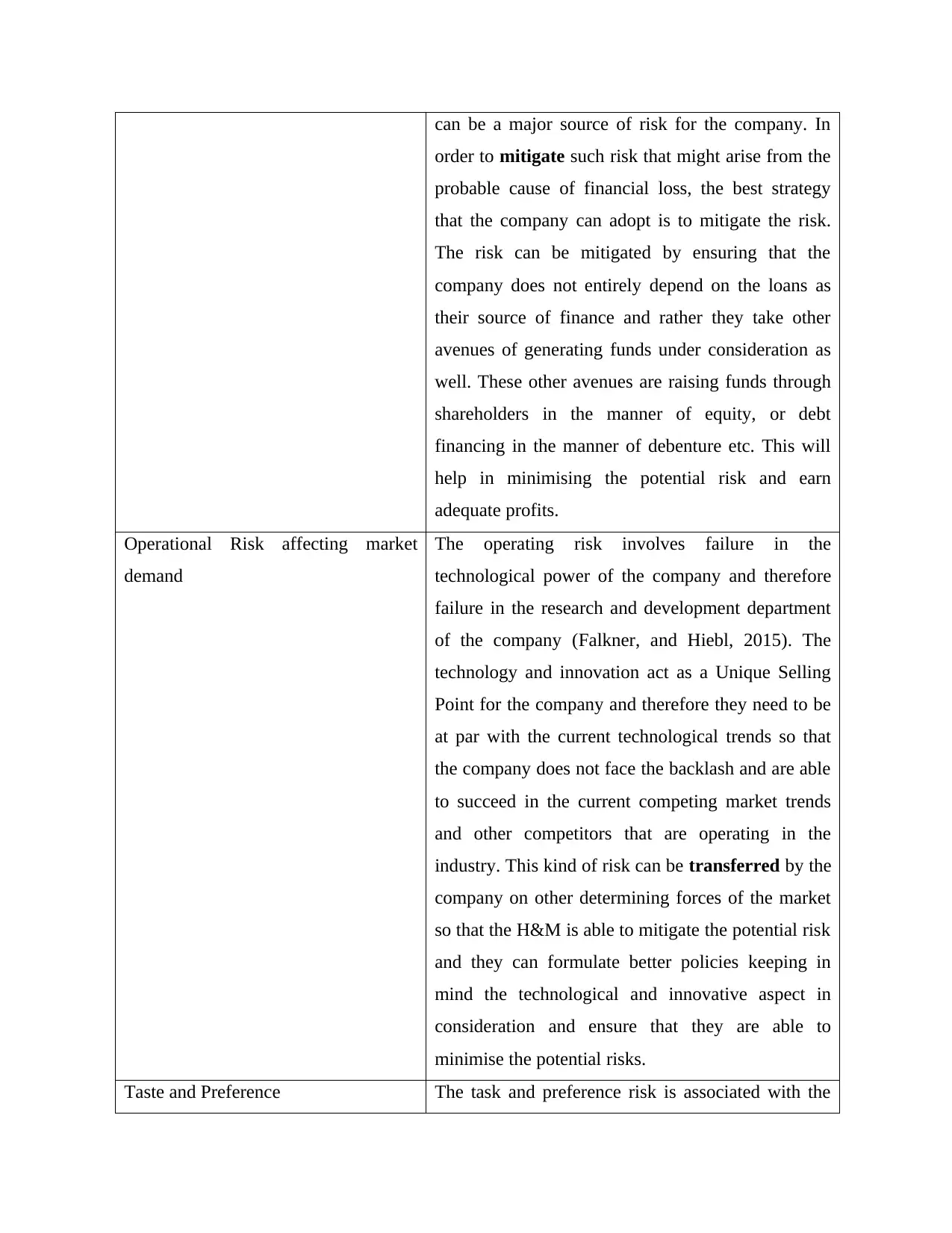
can be a major source of risk for the company. In
order to mitigate such risk that might arise from the
probable cause of financial loss, the best strategy
that the company can adopt is to mitigate the risk.
The risk can be mitigated by ensuring that the
company does not entirely depend on the loans as
their source of finance and rather they take other
avenues of generating funds under consideration as
well. These other avenues are raising funds through
shareholders in the manner of equity, or debt
financing in the manner of debenture etc. This will
help in minimising the potential risk and earn
adequate profits.
Operational Risk affecting market
demand
The operating risk involves failure in the
technological power of the company and therefore
failure in the research and development department
of the company (Falkner, and Hiebl, 2015). The
technology and innovation act as a Unique Selling
Point for the company and therefore they need to be
at par with the current technological trends so that
the company does not face the backlash and are able
to succeed in the current competing market trends
and other competitors that are operating in the
industry. This kind of risk can be transferred by the
company on other determining forces of the market
so that the H&M is able to mitigate the potential risk
and they can formulate better policies keeping in
mind the technological and innovative aspect in
consideration and ensure that they are able to
minimise the potential risks.
Taste and Preference The task and preference risk is associated with the
order to mitigate such risk that might arise from the
probable cause of financial loss, the best strategy
that the company can adopt is to mitigate the risk.
The risk can be mitigated by ensuring that the
company does not entirely depend on the loans as
their source of finance and rather they take other
avenues of generating funds under consideration as
well. These other avenues are raising funds through
shareholders in the manner of equity, or debt
financing in the manner of debenture etc. This will
help in minimising the potential risk and earn
adequate profits.
Operational Risk affecting market
demand
The operating risk involves failure in the
technological power of the company and therefore
failure in the research and development department
of the company (Falkner, and Hiebl, 2015). The
technology and innovation act as a Unique Selling
Point for the company and therefore they need to be
at par with the current technological trends so that
the company does not face the backlash and are able
to succeed in the current competing market trends
and other competitors that are operating in the
industry. This kind of risk can be transferred by the
company on other determining forces of the market
so that the H&M is able to mitigate the potential risk
and they can formulate better policies keeping in
mind the technological and innovative aspect in
consideration and ensure that they are able to
minimise the potential risks.
Taste and Preference The task and preference risk is associated with the
⊘ This is a preview!⊘
Do you want full access?
Subscribe today to unlock all pages.

Trusted by 1+ million students worldwide
1 out of 16
Related Documents
Your All-in-One AI-Powered Toolkit for Academic Success.
+13062052269
info@desklib.com
Available 24*7 on WhatsApp / Email
![[object Object]](/_next/static/media/star-bottom.7253800d.svg)
Unlock your academic potential
Copyright © 2020–2025 A2Z Services. All Rights Reserved. Developed and managed by ZUCOL.





